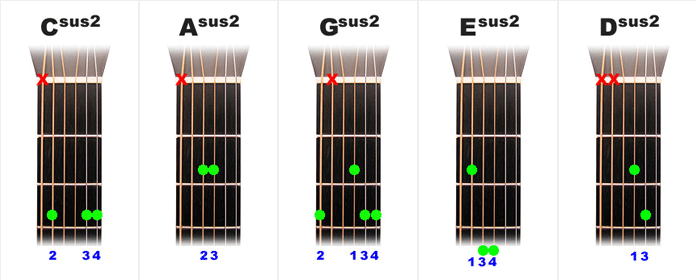The Open sus2 Chords
It really is just a matter of time before you become familiar with the various ways of naming chords, so don't get too hung up on it all at this early stage ...▼
Here are the five open suspended 2nd chords, also known as sus2. In this case, the 3 has been replaced by a 2, so once again the major/minor quality has disappeared, has been suspended, and the sound of the chord is unresolved. These chords, like the sus4s, are not often lingered on for that reason, but some bands have made good use of them.
The diagrams below show the easiest positions for this flavor, but there are more. So long as you have roots, 2s and 5s in the shape, you're playing a sus2 chord. The more you play and the more to refer everything back to the five CAGED shapes, the sooner you'll be able to literally see those numbers on the fretboard.
Here are the 5 open sus2 chords
The green dots show you where to put your fingertips. The red crosses mean 'Don't pluck/play this string'. The blue numbers indicate the best left-hand fingers to use.
1 = index | 2 = middle | 3 = ring | 4 = pinkie.

So that's suspended chords ... the main thing to remember about them is that the 3 goes out the window and is replaced by one of the two notes on either side, namely the 2 or 4. The replacement of the 3 removes any major/minor quality and the resulting sound in both cases is an unresolved, suspended, unfulfilled sound.
More often than not, they're used briefly and are not lingered on for too long, although some modern music does treat them as full fledged chords. When looking for sus chords that aren't one of the five open versions, look first to the A-Form for the barre chord; it's definitely the best option.

Join Our Free Trial
Get started today before this once in a lifetime opportunity expires.
